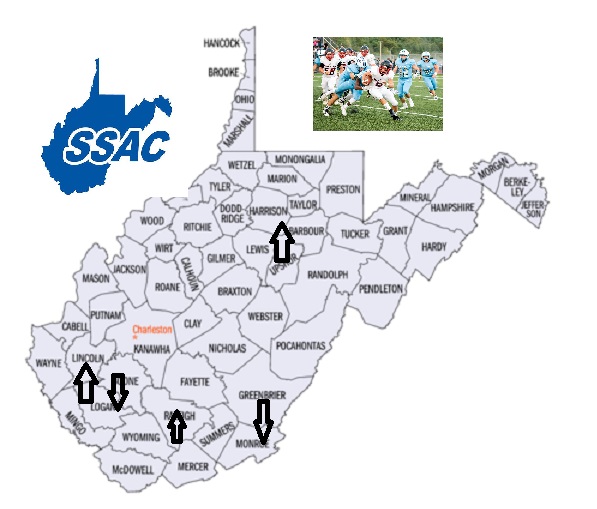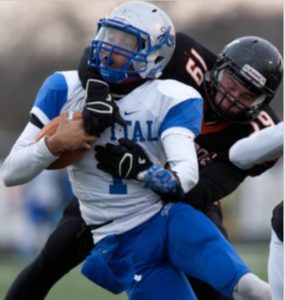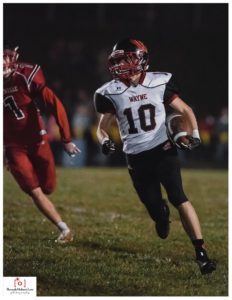Latest SSAC Reclassifications Leave Questions
With the announcement by the WVSSAC that it will move seven West Virginia high schools from class AA up or down a class, there were as many questions created as there were answers provided.
The biggest issue with classification has been the shortage of AAA schools. With just 29 programs in the state’s largest class, first round football playoffs have featured teams with losing records and lopsided scores.
Including more schools in class AAA creates large disparities in enrollment with Cabell Midland showing 1971 students in grades 9-12 in the 2019-20 academic year. By contrast, Ripley has an enrollment of 936. At current, the state’s largest AAA school has double the enrollment of the smallest.
However, enrollments aren’t the only factor for competitiveness. There wouldn’t be much argument that some of the state’s top AA programs in football would be competitive in nearly every sport in class AAA. These schools include Bridgeport, Fairmont Senior, Bluefield, Mingo Central and Winfield.
What do the top AA schools have in common other than enrollment? The answer is location. With the exception of Mingo Central, those schools are located in growing or urban areas where facilities and off-season programs are more bountiful.
While the WVSSAC is still using a classification system that was applicable in 1970, the dynamics of sport has changed immensely in the past two decades. More and more athletes are forced to choose a sport and specialize. Those athletes must focus year-round on that sport and join off-season club programs which require resources like off campus facilities, transportation and sponsors. Those resources are readily available for urban and suburban schools but out of reach for those in rural areas.
This change in sport dynamics has created situations in West Virginia (and many other states) where some rural schools in each class have almost no chance of success at the state level. Simple enrollment numbers are no longer the gage for equality.
If the SSAC if to properly address the classification fairness issue it will have to adapt to a matrix that includes more than enrollment as a factor. Location of a particular school should be included. Urban/suburban equals more. Recent history could be another key factor. Has that school been overly successful in a particular class in the past five years? Is it time to move that school up? Has a school been woefully unsuccessful in it’s current class? Maybe that school gets moved down.
Instead of reclassifying every four years, a new representative board should make changes every two years. Could this create football scheduling issues? Maybe, but much of that could be eliminated by creating two annual variances for schools to play down a class without sacrificing ratings points. This would allow schools to play neighboring rivals without ratings penalties. Who doesn’t want to see Winfield and Poca play? Ravenswood and Ripley? Saint Albans vs. Nitro? Logan vs. Man? We could go on but you get the picture.
Allowing for class variances in football would also reduce travel and increase gate revenues.
The counter argument against a matrix is that it opens up more room for politics. The current system of enrollment is cut and dry except for where the lines will be drawn. For better words, it’s easy. A matrix requires a representative board to make tough decisions about who is rural or urban. Who’s having disproportionate success or failure? That’s a tough job and does the WVSSAC need more challenges?
So let’s look at the changes proposed by the WVSSAC for next year versus our suggestions.
The WVSSAC plans to move Bridgeport, Oak Hill and Lincoln County from AA to AAA. It also plans to move James Monroe, Man, River View and Petersburg down to class A.
We’ll tackle class A first. With the exception of maybe River View were any of the four schools having overwhelming failure at the AA level? That hardly seems to be the case. So why the move to an already crowded class A level? In the case of Petersburg, there could actually be more scheduling problems in football unless our “variance” strategy is implemented.
Now when we take a look at the AAA moves it gets really interesting. Hardly anyone could argue that Bridgeport won’t be very successful at the AAA level. In fact, if we were the Indians we would welcome the move. We say let’s see how we stack up against the big boys. If we can, then that AAA trophy means more than the others. It means we’re at the very top regardless of class. The move works for Bridgeport.
But does a move to AAA work for Lincoln County? Hardly. The rural countywide school boasts an enrollment this year of 855 in grades 9-12. That’s around 70 less than AAA Ripley. The Vikings are another story. Meanwhile the Panthers may barely have the enrollment but do they have the resources and caliber of athletes to be successful in AAA at a regular rate? Hardly. Lincoln County has been in AAA before and it wasn’t pretty.
By contrast, urban school Fairmont Senior with simply 50 less students than Lincoln County remains in class AA where they have dominated and will continue to dominate. Common sense says to move the Polar Bears up to AAA with Bridgeport. After all the two are rivals. The move would create a central quad of AAA schools that included Morgantown and University. Makes total sense in travel and gates.
We see no problem with Oak Hill (enrollment 1102) moving to AAA but let’s toss in Winfield (the 3rd largest AA school, enrollment 790). The Generals have been ultra successful in multiple sports in class AA. Winfield also has the advantage of suburban location allowing it access to facilities and club programs. Furthermore it can schedule easily within the triangle of Charleston, Huntington and Parkersburg.
Those are just a few examples of how things could be made somewhat fair. Plus the great thing about our matrix plan is that it can regularly be tweaked to encourage balance.
One thing is for sure is that sports have changed since 1970. For that matter West Virginia has changed in the past three to four decades. We have a network of highways that reduce travel. We have the internet. Club sports have invaded. We need to continue to evolve with a system that is more adaptive and has the agility to provide the most fair system of classifications.











